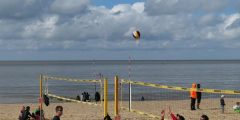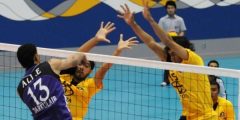Number of players and referees
Handball matches are played by two competing teams, each consisting of six starting players and a goalkeeper. That is, the total number of the handball team is seven players present on the field at one time, and each handball team has the right to make seven substitutions of the main players for the reserve players, who also number seven players, and the substitutions in handball take place during the course of the match when the game is in progress. Active Once the substituted player leaves the field, each team must appoint its own goalkeeper. A regular player can be appointed as a goalkeeper at any time, and the goalkeeper can be appointed as a regular player on the field at any time as well.
A handball match begins if there are at least five players at the start of the match time. Then the number of players on the team as a whole can be increased to fourteen players at any time of the match, whether in regular or extra time. The match can continue if the number of main players is less than five players. It is left to the referees to make this decision; Where handball matches are managed by two referees; They have equal authority to manage the match. The two referees are also assisted by two observers, one of whom is known as the timekeeper, while the other is known as the scorekeeper.
Read also:The difference between tennis and padel
How to play and win
A handball match begins with determining the team in possession of the ball at the beginning of the match by drawing lots by one of the two main match referees. Play begins by passing the players of the team in possession of the ball among themselves with the aim of advancing it towards the opposing team’s goal. This is done by the players using their hands or Any part of their bodies except for their legs and feet, specifically the entire area below the knee. The goalkeeper is the only player who can kick the ball using his feet as long as he is within his own goal area and in the position of defending the goal.
Field players in handball can move only three steps and for a maximum of three seconds while the ball is in their hands. The right to possess the ball goes to the opposing team in the event of a violation of this. Goals are scored by one of the two teams by entering the ball into the opposing team’s goal. The ball must cross the goal line in its entire circumference, and the team that is able to score the largest number of goals during the time allotted for the match is considered the winner.
Stadium and goal
The handball court takes the shape of a rectangle. It is 40 meters long and 20 meters wide, and the stadium is surrounded by four side lines, the two longest of which are called the two side lines. While the two short lines are known as the goal lines, the stadium contains two areas known as the goal areas, and many lines are drawn on the field that are considered part of the area that you define, provided that all drawn lines are five centimeters wide. While the line drawn between the goal posts must be eight centimeters wide.
Read also:Benefits of playing tennis for childrenThe handball court contains two goals, each of which is placed in the middle of each of the goal lines. Each of them must be well fixed to the ground or to the wall behind them. The height of each goal is two meters and its width is three meters. The goal posts are fixed to a horizontal crossbar. The goalposts and crossbar are each eight centimeters wide, and the goal must contain a well-installed net that will keep the ball inside it if it is shot into the goal.
Match time
Official handball matches for adults are played in two halves of half an hour each, with a break lasting a quarter of an hour between the two halves. In matches held for young handball players, The duration of the match can be reduced to forty minutes by twenty minutes for each half, and if the match ends in a draw and the competition requires the need to determine a winning team in the match; Additional periods can be played with two additional periods, each lasting between two and five minutes. Penalty kicks can be used if the two teams are still tied after the end of the additional periods. Each handball team is entitled to one time-out during the original periods of the match. The duration of this time is only one minute.
Handball balls
The handball match is played with a round ball, provided that it is not shiny and smooth. The sizes of the balls used in handball vary depending on the ages of the players. Men and women over the age of sixteen play with a ball weighing between 425 to 475 grams, and its circumference is between 58 cm and 60 cm. Male players between the ages of twelve and sixteen years old play, and female players over the age of fourteen years play. Rollers weigh between 54 to 56 grams and their circumference ranges from 54 cm to 56 cm.
Read also:Research about volleyballYoung men whose ages range from eight to twelve years and girls whose ages range from eight to fourteen years play with balls whose weight ranges from 290 to 330 grams and whose circumference ranges from 50 cm to 52 cm. It must be noted that the balls used in The handball must be made of leather or similar synthetic materials.
Types of throws
There are many types of throws that are obtained in handball matches, and they are as follows:
- Side throw: The team gets a side throw when the opposing team takes the ball off the field, and it is executed from where it leaves the field. During the execution of the side throw, all players on the opposing team must stand at least three feet away from the player executing the side throw.
- Free throw: The team wins a free throw if one of its players is exposed to a mistake or a minor violation by a player on the opposing team. This throw is taken from the place where the mistake occurred.
- Penalty throw: The opposing team is awarded a penalty kick when a player commits a foul that causes a clear scoring opportunity to be lost, or when the team's goalkeeper picks up the ball and returns it to his own goal area, or when a player intentionally passes the ball to his goalkeeper inside the goal area or attacks a defending player while he is there. In his team's goal area for the attacking player who has possession of the ball, the player does not have to adhere to the three-second rule while executing the penalty throw, which is also known as the seven-meter throw, because it is executed from a line seven meters away from the goal line.
- Goal throw: The team gets a goal throw when the opposing team releases the ball from the side of the two end lines on the field or leaves that side after bouncing off the goalkeeper.
Passive play
There are many things that a team's players may do to result in what is known as negative play, which is warned against with a signal from the referee to avoid it. If the team continues to play passively, possession of the ball is transferred to the other team by granting them a free throw, depending on لقوانين International Handball Federation. In some cases, a free throw is awarded against the team in possession of the ball without a prior warning signal from the referee. Among the matters in which play is considered negative is when the team retains the ball without any clear attempt to attack and score, or when the implementation of any of the side or free throws is delayed. Or even a goalkeeper's shot.
Fouls and penalties
There are many errors that may be committed by handball players, and when these errors occur, they require the referee to issue a specific penalty against the player who committed the violation, and the penalty that is directed at the player varies depending on the type of violation and the error that he committed. The following shows some of the penalties in the game. Handball and the fouls that require issuing these penalties:
- Errors that require an immediate stop for two minutes: It is as follows:
- Holding or pulling the opposing player for a long time.
- Directing a hard blow against the player's arm when throwing the ball.
- Intentionally making the opposing player lose control of his body.
- Jumping or running at high speed towards the competitor.
- Committing a foul against an opposing player who is running fast.
- Fouls that require the player to be disqualified: It is as follows:
- The player's inability to actually control his body while throwing the ball or while running or jumping.
- Violently attacking any part of the opposing player’s body, especially the neck area.
- The player was extremely reckless when he committed a certain violation.









